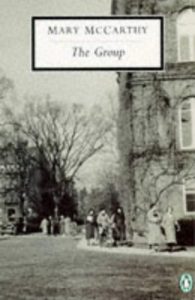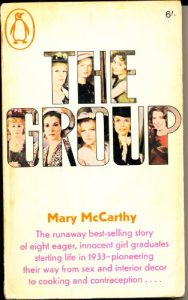 I read first read The Group in 1963 not long after it was published. I was a callow, shallow sixteen year old. Word on the street was that this book included explicit sex. There wasn’t too much of it about then (less than three years after the Lady Chatterley’s Lover trial) and we were hungry for it. Rereading it now in the coolness of maturity I notice that yes, there is some sex there, but it’s bluntly matter of fact and not remotely erotic. I doubt I understood the difference in 1963.
I read first read The Group in 1963 not long after it was published. I was a callow, shallow sixteen year old. Word on the street was that this book included explicit sex. There wasn’t too much of it about then (less than three years after the Lady Chatterley’s Lover trial) and we were hungry for it. Rereading it now in the coolness of maturity I notice that yes, there is some sex there, but it’s bluntly matter of fact and not remotely erotic. I doubt I understood the difference in 1963.
Mary McCarthy’s best known novel details the lives of eight women in their twenties. They graduated from Vassar in 1933 and this is what happened next. They’re all bright and ambitious in their different ways but marriage and childbirth proves restricting – in what soon became a seminal feminist novel.
I find the timing fascinating. I’m over thirty years behind the women depicted but I can identify totally with some of their predicaments. Priss’s paediatrician husband wants her to breastfeed their son but she finds it difficult and nobody else – family, friends, nursing staff is committed to it. That was exactly the situation I encountered, at least with medical professionals, when my babies were born in Britain in 1972 and 1976 – except that I’m a lot more bloody minded than Priss is and did it anyway. Interestingly they were told then (as I was in 1972) that you had to stick to a 10.00/2.00/6.00 feeding routine through the 24 hours so that the baby would soon learn to sleep though the night. I’ve wondered for decades how/why it is that my fully breast fed boys slept through at 3 months and modern children seem to go on waking up in the night until they’re at least 2 years old. Perhaps there’s something in the old ways. McCarthy contrasts this with Norrine’s “Bohemian” child-centred approach which is, of course, exactly what young mothers are advised to do now. It certainly set me thinking. But of course, these issues passed me by completely in 1963 when I hadn’t even taken my O levels.
Then there’s Polly who has an affair with Libby’s married publisher boss which clearly isn’t going anywhere. Eventually she settles amiably for a decent doctor – there’s no passion but it’s a workable marriage. Haven’t we all known people like this? McCarthy’s observation is very sharp.

The book is structured around Kay – first her short-lived marriage to the rather tiresome, pretentious, wannabe actor/playwright/director Harald – and eventually her funeral aged 29, which neatly brings the whole group back into the same space. Kay, a “blurter” who can’t help saying what she thinks, puts her own career on hold – taking a fairly menial job at Macys – in order to support Harald who never achieves anything much and is serially unfaithful.
Some members of the group remain single and are therefore able to do the work they’ve chosen without reference to anyone else – although parents are quite prominent in this novel too. One goes off to Europe and returns after the outbreak of war with a lesbian partner who is, after initial awkwardness, cheerfully accepted by the rest of the group as any other husband would be. These women, have after all, had a liberal education.

One of the most disturbing episodes is Kay’s being committed to a mental hospital by Harald. She is not mentally ill but cannot be discharged without Harald’s permission. That’s chilling. As I often opine, some things have improved – and female equality is one of them on both sides of the Atlantic.
The Group, now 60 years old, speaks of both the 1960s and the 1930s. It has worn very well. It’s funny in places and the writing is needle-sharp. But don’t bother to read it for the explicit sex.
Next week on Susan’s Bookshelves: The Darling Buds of May by HE Bates